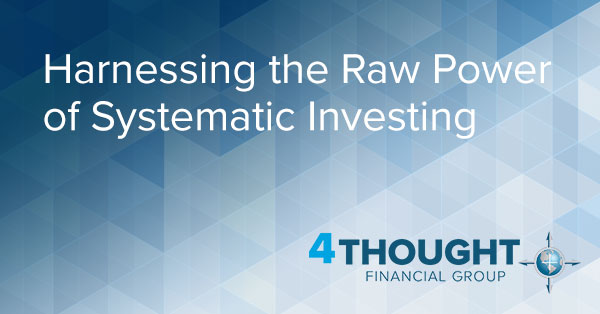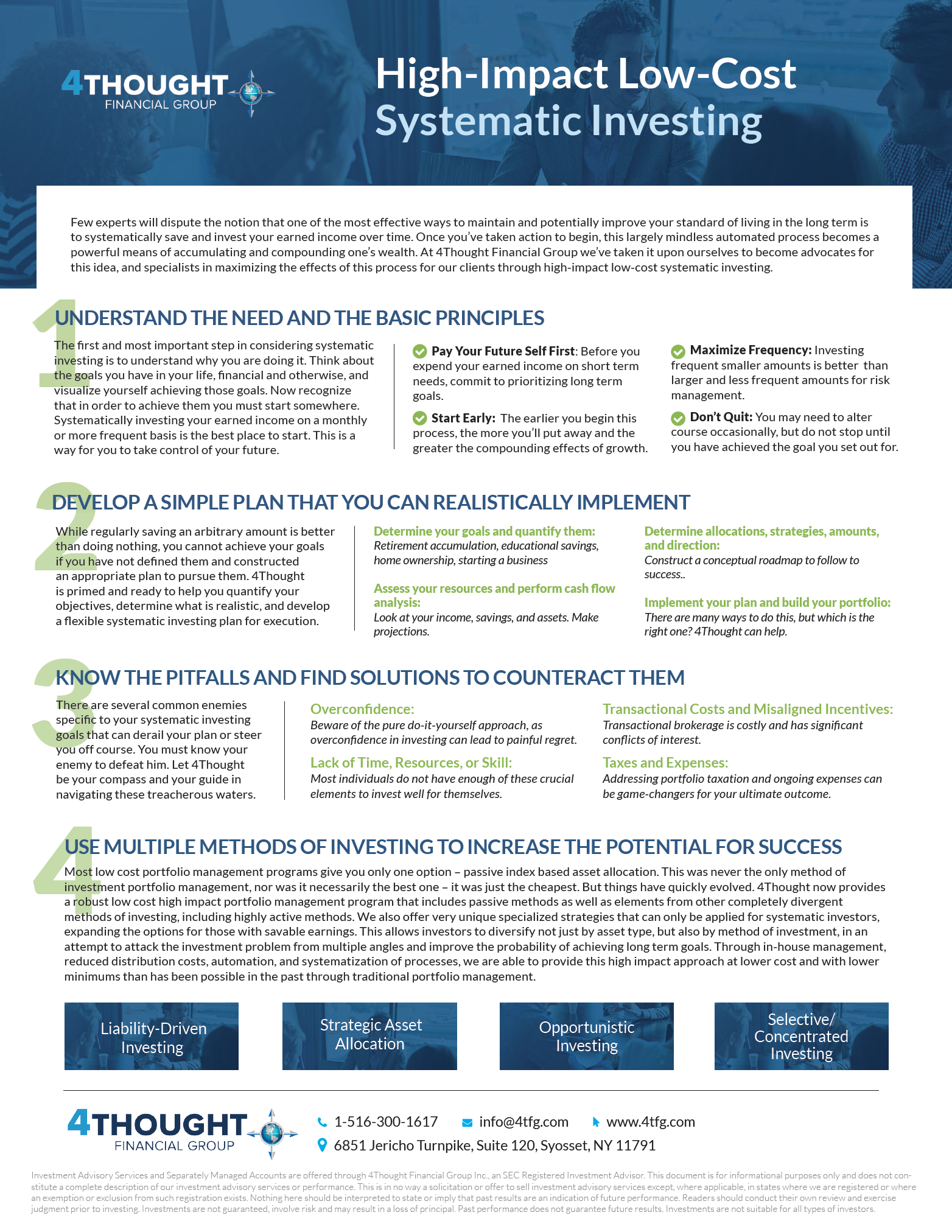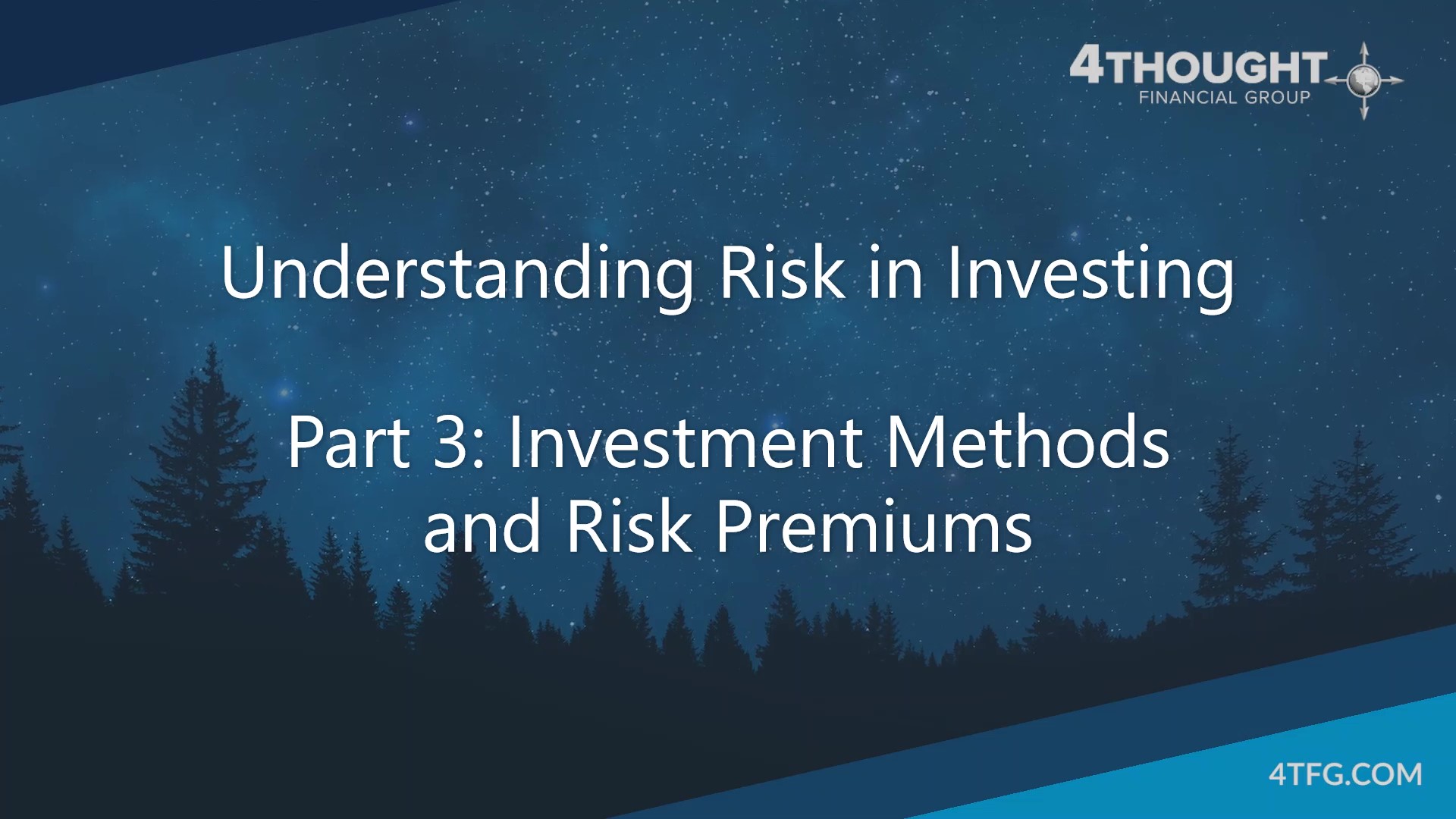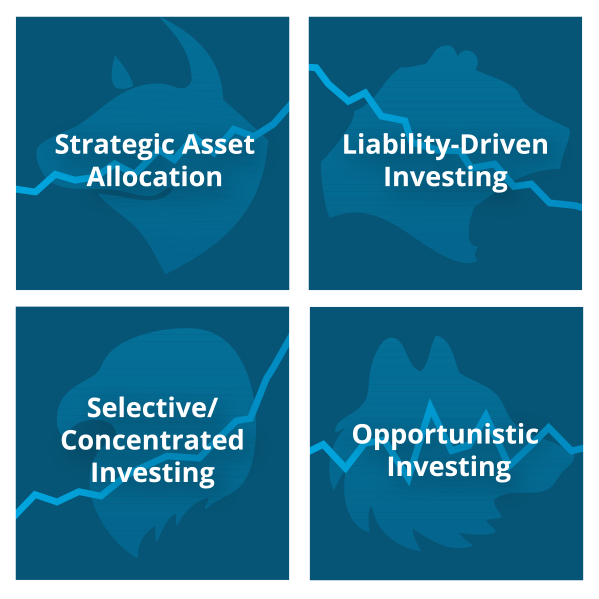

Systematic Investing with 4Thought Financial Group
"One of the most effective ways to maintain and potentially improve your standard of living in the long term is to systematically save and invest your earned income over time."
There are very few concepts in financial planning that hold as much raw power to transform one’s life as systematic investing. But harnessing the potential extreme force behind this concept often proves tricky when it comes to actual implementation.
When using the term “systematic investing” here we are not referring to a formulaic or rules-based ongoing portfolio management approach (which can also be quite powerful), but more simply to the process of regularly contributing a fixed amount of earned income (cash) into an investment portfolio at predetermined intervals and in predetermined amounts—also sometimes referred to as a systematic investing plan (SIP). This concept is closely related to “systematic savings” (which refers to regularly placing earned income into a bank checking or savings account), but with the added potential for long term portfolio growth conferred by investing in stocks, bonds, and other asset types (rather than just cash and cash equivalents). Systematic investing combines the power of systematic savings with the power of compound interest (which Albert Einstein purportedly once called “the most powerful force in the universe”).
Most individual investors are first introduced to systematic investing through an employer-sponsored retirement savings plan in the form of a 401(k), which provides the additional benefits of tax deductibility of earnings contributions and tax deferral of growth. But even without the tax benefits of a 401(k) plan, systematic investing as a stand-alone concept holds incredible power in its potential to transform an investor’s future. For the individual investor it is the most fundamentally important tool for achieving long term financial goals. Systematic investing is a means to start with next to nothing and potentially ultimately achieve whatever lifetime financial goal one can imagine. When you think about it from that perspective, it is truly amazing.
Here is a simple illustration of the concept:
- The Power of Compound Interest: If you start with $1,000 and then invest nothing further in an investment portfolio that generates an average rate of return (net of fees and taxes) of 7% per year for 10 years, you will end up with $1,967.15 at the end of the 10 year period. The money almost doubled in value with little or no labor on the part of the investor (just the investor’s capital working for them) over this time period.
- The Power of Systematic Savings: If you start with $1,000 and then save $1,200 per year (only $100 per month) in a bank checking account that generates an average rate of return of 0% per year for 10 years, you will end up with $13,000 at the end of the 10 year period. This illustrates the effect of the investor’s saved earnings (the investor’s labor) over this time period.
- The Power of Systematic Investing (Compound Interest and Systematic Savings working together): If you start with $1,000 and then invest $1,200 per year (only $100 per month) in an investment portfolio that generates an average rate of return (net of fees and taxes) of 7% per year for 10 years, you will end up with $18,546.89 at the end of the 10 year period. This illustrates the multiplicative effects of labor and capital working together over the time period—a very powerful combination. We used annual compounding here. The effect is even greater if we put the $100 to work right away instead of waiting until the end of each year and assume monthly compounding (the end result is $19,318.14 in that case).
- Starting with Nothing: Even if you start with nothing ($0 instead of $1,000 in this example), and then systematically invest $100 per month in an investment portfolio that generates an average rate of return (net of fees and taxes) of 7% per year for 10 years, at the end of the 10 year period (again, assuming monthly compounding) you’ll end up with $17,308.48. Not bad for starting with nothing and saving a very modest amount each month.
While the purely mathematical computations shown here provide a good illustration of the undeniable potential of the systematic investing concept to dramatically improve peoples’ financial lives, there are two major assumptions made in these simple linear projections that may or may not pan out in real life implementation. The first problematic assumption has to do with the rate of return, and the second has to do with the persistence and behaviors of the investor.
The assumed 7% linear rate of return used in the illustration is just an assumption and does not represent the actual historical (or future) performance of any particular portfolio of investments. The actual long term average rate of return that any investor experiences in the future will depend on a variety of factors, including their asset allocation mix (the percentage split between stocks, bonds, and other assets); the performance of the broader financial markets in the future; the idiosyncratic risks and returns of the specific securities, investment products, and investment managers used; the fees and expenses incurred by the investor; the taxation of the portfolio; the investor’s subjective tolerance for risk; the investor’s time horizon until the money will be accessed; the sequence of returns (since the investor will not get the same return each year); the investor’s behavior and ability to ride through market volatility without making self-damaging moves; and many other factors.
To put this in context, in order to achieve the 7% rate of return used in this illustration after considering all of these “reality” factors, the investor would likely have to target an asset allocation mix of close to 100% stocks (a very aggressive and volatile portfolio) in order to attempt to achieve a long term gross return in the neighborhood of 10% per year since fees/expenses and taxes will erode the gross return over time, bringing the net return closer to 7%. Analytically this may be achievable, but when we then consider that investors are human beings that have emotions and short term needs that often prevent them from taking such significant risks, and that humans are capable of making mistakes in investing (and most often do), then we can recognize why the historical experience of investors is an average return that is actually often significantly less than the 7% assumption used here—even if they use an aggressive and volatile 100% stock allocation.
The second problematic assumption of the illustration is that the investor may not be capable of persistently contributing their $100 per month (or whatever other amount applies) each and every month for 10 years (or whatever other time period applies). Historical experience reveals that there will almost always be deviations from this process, even among the most diligent and resolute of investors. This is because things change in people’s lives as time passes. They may lose a job for a period of time, have an unexpected expense that comes up, or have some other life event that interrupts their ability to consistently contribute to their account. Also, their financial goals and objectives may change due to some life event. More commonly though, investors may be easily distracted from their original plans and redirect their savings to some other pursuit or “investment opportunity” (which often turns out to be more of a pitfall than an opportunity). However, the good news is that there are solutions to many of these problems.
The ultimate success of a plan of systematic investing, and the determination as to whether the investor’s long-term accumulation goals will actually be achieved, is highly dependent on the effectiveness of the practical day-to-day implementation of the plan. Here are some practical steps that can be taken to improve one’s success rate:
- Don’t get overconfident: One of the most common individual investor mistakes is to assume that they are somehow more capable of selecting securities or timing the markets than armies of professional investment management firms or than the broader markets as a whole. Trying to pick winning stocks or jump in and out of the market as an individual investor is a loser’s game. If an individual investor wants to systematically invest on their own, their only real shot at success is to use low cost “no-load” broadly diversified index-tracking mutual funds and simply buy and hold. But that’s not necessarily the best approach—which leads to the next piece of advice.
- Use the right professional help: There are two primary functions that one needs professional help with in this process. The first is in developing the systematic investment plan. For this, one needs a competent and properly incentivized financial planner or wealth manager. The second is ongoing portfolio management (plan implementation)—for which monetary incentive is also key. The planning element will be best conducted by a fee-based financial planner who is preferably being paid based on an ongoing retainer fee, under which they are also doing all of the other broader financial planning for the client, including not just investment planning, but also estate planning, employer/employee benefits planning, and business succession planning (in the case of business owner clients). Such an overarching coordinator is best equipped to properly develop the systematic investing plan within the context of all the other things going on in the investor’s financial life. Secondarily, the ongoing portfolio management (plan implementation) element is often best executed by a fiduciary Registered Investment Adviser (RIA) money manager who will most likely charge an “asset-based fee” (an annual percentage of the assets under management). A “robo-advisor”, which is a low-cost (but often low-service) digital version of the RIA, may also be a viable alternative for implementation of the plan. In some cases, and perhaps optimally, the two functions can be performed by the same firm to provide maximum coordination, a lesser degree of implementation errors, potentially lower fees, and alignment of the investor’s objectives with the monetary incentives of the professionals. Once you’ve selected the right professional help, they should be able to aid you with every other consideration listed below—or take care of all of it for you.
- Visualize your goals, quantify them, and determine the planned savings required: The most important part of the whole process is to know what you want to achieve and commit to it. Saving for retirement?, your kids’ educations?, to start a business?, to buy a home? Figure out when you want it to happen and in what amount with the help of your professional financial planner. Getting a handle on the associated numbers will tell you exactly how much needs to be put away regularly towards each objective. The actual calculation is simple—it’s determining the subjective elements that may prove more challenging.
- Start investing early—don’t wait: When it comes to systematically investing, the sooner the investor starts, the greater the probability of achieving the long term goal. Due to the nature of compound interest, larger and earlier investments have a disproportionately large effect on the long term outcome—so don’t wait. Even if you can only start with a very small amount, this can potentially have a greater long term effect than you’d expect.
- Invest frequent small amounts at regular intervals to reduce timing risk—and avoid ad hoc judgments about timing and amount: One of the main benefits of systematic investing is the ability to spread out and reduce the risks associated with the timing of your investment in the financial markets. If you unwittingly invest a large chunk of money near the top of a market cycle, this will hurt your long term returns prospects, whereas a large chunk invested near the bottom of a market cycle will improve your long term returns prospects. The problem is, no one really knows when that market top or bottom is coming—so if you wait and try to dump money into your portfolio at the right time then you’re taking an unnecessary gamble. For the long term investor, the smaller and more frequent the cash investments into the portfolio (at regular intervals), the lower the market timing risk (based on the ability to buy at both high levels and low levels—moderating the average price of purchase).
- Systematically invest—Don’t “dollar cost average”: Systematic investing often gets confused with “dollar cost averaging”, but these concepts are actually not the same. While both have the potential to moderate the average price of purchase, there is a significant difference—related to “cash drag”. Systematic investing is based on taking cash recently earned through employment activities and putting it directly to work in the investment portfolio, minimizing the time that the money is held as cash. Dollar cost averaging, on the other hand, often involves starting with a large sum of cash, and then incrementally dispersing this money into the stock/bond investment portfolio over time. Dollar cost averaging in this form is actually a form of betting on a market decline since the assets will be temporarily held in cash, potentially for an extended period of time, during which it’s purchasing power may be eroded by inflation. In a rising market environment (which is much more commonly the case than not on a historical basis), this creates a drag on the overall returns of the portfolio—a drag that is virtually eliminated through true systematic investing.
- Set up automated contributions—don’t rely on yourself to remember: It is one thing for the investor to decide that he/she is going to systematically invest $100 each month, but another thing entirely to actually remember to do it and act on it every single time without failure. For this reason, the best way to execute the plan is to have the decided amount automatically deducted from the investor’s paycheck or bank account and automatically contributed to the investment portfolio—leaving the flawed ongoing human decision making out of the picture.
- Minimize taxation: Taxation is one of the biggest hurdles to overcome when it comes to investing. Typically 20% or possibly more of a portfolio’s annual gains can be eroded by capital gains, dividend, and income taxes—if the right steps are not taken. For systematic investing towards retirement, often the best course of action is to use tax-advantaged account types such as a 401(k), Traditional IRA, or Roth IRA (amongst many others), which may provide the potential to deduct contributions on the tax return and defer taxes to a later date, or to take care of the taxation up front so that money can be pulled out of the account tax free on retirement (in the case of a Roth). But if your accumulation goal is not for retirement, but for something else, or if you’re not eligible to contribute any more to a tax advantaged account type, then tax minimization becomes far more complex. In this case, the use of the right investment vehicles, such as index-tracking exchange traded funds (ETFs) over traditional open-end mutual funds may help, since ETFs tend to be more tax efficient. More importantly, the portfolio must be competently managed using specialized tax minimization techniques such as tax loss harvesting, tax transitioning, tax location (using separate accounts), and low turnover management. Professional management is likely required in these areas.
- Minimize expenses: Another (potentially major) drag on your portfolio returns over time will be the expenses associated with the initial building and ongoing management of the portfolio. Traditionally the only reasonably effective way to do systematic investing for the retail investor has been through open-end mutual funds, due to their relatively low minimum initial investments and their percentage-based sales charge on purchases (as opposed to a fixed dollar commission charge). This is because the alternative route of buying individual stocks in small amounts in a brokerage account subjects each small transaction to a comparatively large fixed dollar commission charge—destroying potential growth, and making this approach untenable. But even when mutual funds are purchased through an advisor in the form of A-Shares (the most common way to do this), then a substantial amount of each investment (both initial and subsequent regular contributions) is taken right off the top (typically 3-5%) for the sales charge, and then the internal expense ratios of the funds will apply on an indefinite basis (typically in the range of 1.00-2.00% per year), both of which will severely damage long term returns. Luckily, developments in financial technology and persistent downward pressure on fees in the industry have led to the more recent development of asset management programs using private separately managed accounts that are characterized by low (or non-existent) minimum initial investments, no sales charges, low ongoing portfolio management or investment advisory fees, and very low internal fund expense ratios (through the use of exchange traded funds and individual stocks instead of traditional actively managed mutual funds). In such programs, the two main (or only) expenses are the fee paid to the portfolio manager/advisor for running the portfolio (which may range from less than 0.25% up to 1.85% or more), and the internal expense ratios of the ETFs and/or individual stocks used (which typically range from 0% to 0.75% or more). If the right “separately managed account” or “robo-advisor” programs are used, the expense problem can be significantly reduced, while also keeping the monetary incentives of the portfolio manager largely aligned with the goals of the investor.
- Make investment decisions based on data analytics and rules-based systems, not based on feelings: Relying on one’s intuition or feelings for investment portfolio management often proves disastrous. Studies in Behavioral Finance and Behavioral Economics have repeatedly shown that human beings are capable of shooting themselves in the financial foot over and over again if they have not set an appropriate set of guidelines, repeatable processes, or rules for themselves. It is for this reason that when systematically investing earned income into a portfolio, one should also use the other kind of “systematic investing”—which involves using a predefined algorithmic or formulaic process for the actual internal day-to-day portfolio management decision making. At the very least, having some basic decision-making guidelines in place prior to being presented with a situation leads to clearer, faster, and more decisive thinking. But at a more extreme level this concept can be implemented by specialized professionals in the form of algorithmic quantitative models or even full trading automation.
- Take advantage of new cash to invest all the time: A unique advantage of systematically investing fixed dollar amounts of cash on a frequent and regular basis (as compared to simply investing a one-time lump sum of money) is that the investor constantly has new cash to deploy all the time. This confers a tax advantage if done within a non-tax-advantaged account. Since most managed portfolios have at least some portfolio turnover from trading or rebalancing that occurs within the account, the new cash that is added to the portfolio each week or month can be used to alter the composition of the portfolio, instead of having to sell a portion of the existing holdings. Since one doesn’t necessarily have to sell something in order to buy something, this means that the capital gains tax liabilities are likely to be lower for an account that receives systematic cash as compared to the same portfolio that does not. This is especially true if the portfolio manager is aware of this fact and is able to time any planned trading of the account to coincide with the addition of the new cash to the account. Another advantage is that specialized systematic investing portfolio management programs can be found that are designed to take advantage of the frequent new cash to invest, for example by using quantitative data analytics to identify assets or securities that may be purchased at value prices on the day that the new cash arrives each time, thereby attempting to potentially improve risk-adjusted returns (this should only be attempted through specialized professionals – lest one shoot oneself in the financial foot as mentioned earlier).
- Reassess savings needs regularly, and correct course as necessary: One of the most important practical steps to actually achieving a long-term accumulation goal through systematic investing is to regularly reassess progress and make adjustments to the amount being systematically invested as necessary. Although it is often advisable to automate as much of one’s systematic investment plan as possible to avoid the temptation to unnecessarily alter the planning, it is crucial to (at least annually) perform an objective data-driven assessment of one’s progress towards the objective—preferably guided by the hand of a qualified professional, as discussed earlier. This will allow for increases or decreases in the amount regularly saved as necessary based on changes in the investor’s life circumstances and based on broad market movements. An added advantage of doing this is that by recalculating the required systematic investments needed to achieve the objective each year and creating a new goal projection, this may provide a systematic way to improve results. If one does the linear calculation at the bottom of a bear market, the calculation will tell the investor to invest more (which will be relatively beneficial when the market recovers), and if one does the linear calculation at the top of a bull market, the calculation will tell the investor to invest less (which will be relatively beneficial if the market then declines).
Taking heed of the many pitfalls associated with systematic investing is an important step towards the development and implementation of a good real-world systematic investment plan. Although compound interest and systematic investing are often cited as powerful means to achieving long term financial objectives, the truth is that the practical implementation rarely measures up to the theory. For this reason it is imperative to use the best conceptual tools of finance to prevent the erosion of portfolio performance so common in systematic investing, and thereby significantly improve the probability of the investor’s success.
AUTHORSHIP:
Jesse Mackey is the Chief Investment Officer and a shareholder of 4Thought Financial Group Inc., a Registered Investment Adviser and money manager that advocates for systematic investing and utilizes Multi-Method Investing as the theoretical basis of client portfolio management.
© Copyright 2018 Jesse B. Mackey. All rights reserved.
DISCLOSURES:
Investment Advisory Services offered through 4Thought Financial Group Inc., an SEC Registered Investment Adviser.
The content presented here is for informational purposes only and does not constitute a complete description of our investment advisory services or performance. This document is in no way a solicitation or offer to sell securities or investment advisory services except, where applicable, in states where we are registered (or notice filed) or where an exemption or exclusion from such registration exists. Any opinions presented here are subject to change at any time without notice. Readers should conduct their own review and exercise judgment prior to investing. The information provided by 4Thought is for general educational and conceptual purposes only and is not to be interpreted or construed as investment advice meant for particular individuals. The returns presented in this document are used for illustrative purposes only and do not represent the performance of any particular investment or any investment offering of 4Thought Financial Group Inc. Investments in vehicles that may be used to attempt to achieve the (purely theoretical and illustrative) returns presented in this document (such as Separately Managed Accounts, exchange traded funds, or mutual funds) may fall as well as rise; are not guaranteed; are invested with a significant risk of loss; are not FDIC-insured; and are not a deposit of or guaranteed by a bank or any other entity. Investors in such vehicles should carefully consider the investment objectives, risks, charges and expenses. Past performance does not guarantee future results.







Leave a Comment